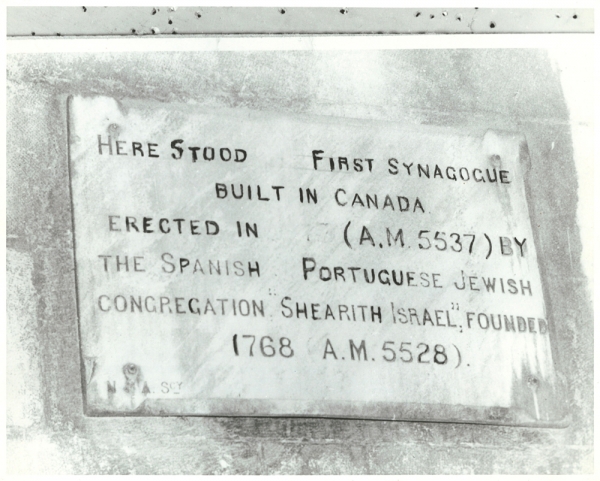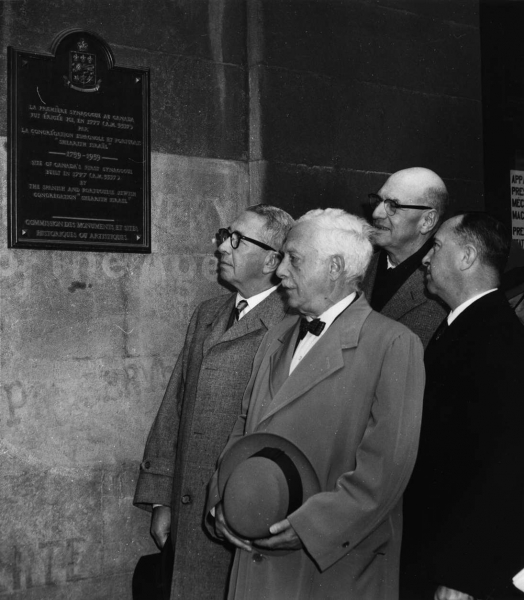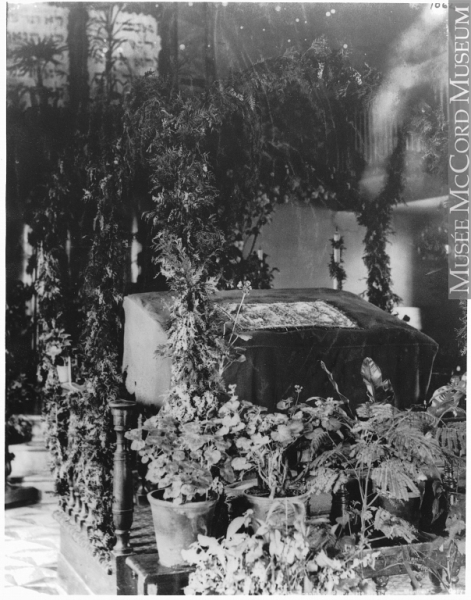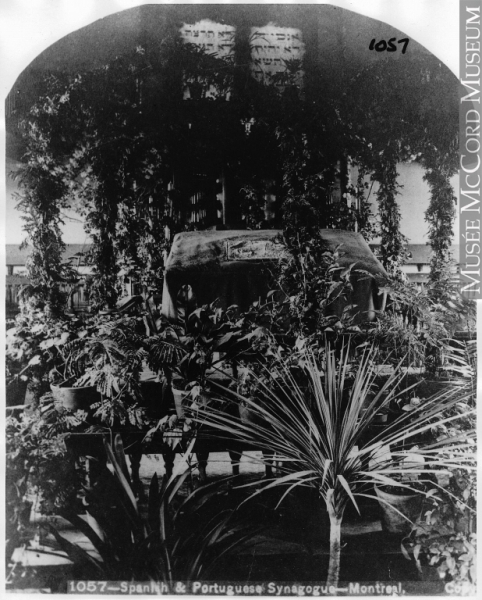Shearith Israel (Spanish and Portuguese Synagogue)
1777 - 1825
Place Marguerite-Bourgeoys, Rue Notre-Dame Est
Shearith Israel (“the remnant of Israel”) has the distinction of having been the first synagogue in Canada and the first non-Catholic religious institution in Quebec. The original synagogue building was erected in 1777 at the corner of St. James and Notre-Dame Streets. It housed the Congregation Shearith Israel, founded in 1768 and numbering some fifteen members at the time. Also known as the Spanish and Portuguese Synagogue, the new institution was committed to the unification and development of the community, and thus quickly became the focal point of Jewish activities in Montreal. Confronted with the question of whether to use the Ashkenazi or Sephardic rite, its founders opted to follow Sephardic traditions. Although mostly Ashkenazi themselves, they wished to ensure support from the Sephardic congregations of Shearith Israel in New York (from which the Montreal synagogue took its name) and Bevis Marks in London.
In 1825, the death of David David, the owner of the lot on which the synagogue was built, made it necessary for the congregation to relocate. Its members met in the home of businessman Benjamin Hart until the dedication in 1838 of a new synagogue on Chenneville Street. However, tension between the city’s newly-arrived Ashkenazi immigrants and the established members of the community soon resulted in a rift. The Ashkenazis’ sense of being treated as second-class citizens, coupled with their unfamiliarity with Sephardic traditions, was at the root of tensions that ultimately led to the creation of the Ashkenazi synagogue Shaar Hashomayim in 1846. This event coincided with the arrival of Abraham de Sola from England to lead Shearith Israel. Having suffered in the 1820s and 1830s from short-lived tenures and outright vacancy in its pulpit, the congregation had its first true leader in de Sola. The reverend reaffirmed the congregation’s Sephardic vocation and undertook projects to revitalize the community’s educational, mutual support and philanthropic infrastructures. Following De Sola’s death in 1882, his son Meldola followed in his footsteps.
By 1890, the Spanish and Portuguese Synagogue had grown tenfold and gained in prosperity. Expansion prompted a move to Stanley Street, in the “uptown” area where most of its members now lived. Many were well-off Jews who had integrated into Montreal’s English-speaking society. The arrival after 1945 of immigrant survivors of World War II in the city’s western neighbourhoods and the shift of a large portion of the Jewish community to the suburbs resulted in a decision to move the synagogue one last time to the Côte-des-Neiges-Snowdon neighbourhood in 1947. During the 1950s, the congregation grew further with the arrival of Sephardic Jews from northern Africa and the Middle East. Today, the synagogue is known for its tolerant and welcoming approach. To accommodate its culturally diverse community, it organizes minyanim (religious services) in various liturgical traditions.
Compiled by Valérie Beauchemin, translated by Helge Dascher.
Links
Liens
"Shearith Israel" - Canadian Jewish Heritage NetworkSpanish and Portuguese Synagogue - Website
Sources
King, Joe. Fabled City: the Jews of Montreal. Montréal: Éditions Price-Patterson Ltd, 2009.
King, Joe. Les Juifs de Montréal: Trois siècles de parcours exceptionnels. Montréal: Les Éditions Carte blanche, 2002.
Medresh, Israël. Montreal of Yesterday. trans. Vivian Felson. Montreal: Véhicule Press, 2000.
Smith, Mackay L. The Jews of Montreal and their Judaïsms: A Voyage of Discovery. Montréal: Aaron Communications, 1998.
Stern, Malcolm H. “Portuguese Sephardim in the Americas.” American Jewish Archives 44 (1992):141-178.
Tauben, Sara. Aspiration and Adaptations: Immigrant Synagogues of Montreal, 1880s-1945. Master's Thesis, Concordia University, 2004.
Tulchinsky, Gerard J. J. Canada’s Jews: A People’s Journey. Toronto: University of Toronto Press, 2008.
Tulchinsky, Gerard J.J. Taking Root: The Origins of the Canadian Jewish Community. Hanover: Brandeis University Press, 1993.
*Images courtesy of the Jewish Public Library Archives, the Canadian Jewish Congress Charities Committee National Archives (CJCCCNA), and the McCord Museum.


This project is funded in part by the Government of Canada.
Ce projet est financé en partie par le gouvernement du Canada.
Ce projet est financé en partie par le gouvernement du Canada.
This project is funded in part by the Government of Canada.
© 2011-2015 Museum of Jewish Montreal, All Rights Reserved.
Site by Air Code Design inc. ![]()
© 2011-2015 Musée du Montréal Juïf, Tous droits réservés. Site par Air Code Design inc. ![]()




